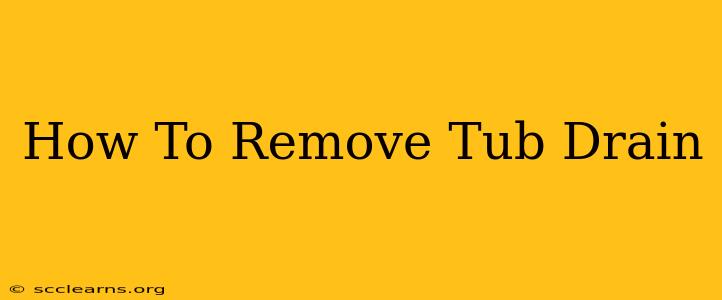Replacing a leaky or clogged tub drain can be a surprisingly straightforward DIY project. This guide will walk you through the process of removing your tub drain, whether it's a simple slip-joint drain or a more complex one with a trip lever. Remember safety first! Always turn off the water supply before starting any plumbing work.
Tools You'll Need
Before you begin, gather the necessary tools. Having everything on hand will make the process smoother and more efficient. You'll likely need:
- Adjustable pliers: For loosening and tightening nuts and bolts.
- Slip-joint pliers: Useful for gripping pipes and fittings.
- Screwdrivers (Phillips and flathead): Depending on the type of drain you have.
- Putty knife or scraper: For removing old caulk.
- Bucket: To catch any spilled water.
- Rag or sponge: For cleaning up spills.
- Flashlight: To illuminate the work area, especially under the tub.
- Optional: Basin wrench: Makes accessing hard-to-reach nuts much easier.
Types of Tub Drains & Removal Techniques
There are several types of tub drains, each requiring a slightly different removal process. Let's look at the most common:
1. Slip-Joint Tub Drain
This is the simplest type. The drain assembly is held together by slip nuts.
Steps to Remove:
- Locate the slip nuts: These are usually located under the tub, connecting the drain tailpiece to the drain flange and the overflow pipe to the drain body.
- Remove the overflow plate: If your drain has an overflow plate, you'll need to carefully remove it (usually with a screwdriver).
- Loosen the slip nuts: Using adjustable pliers, carefully loosen and remove the slip nuts connecting the various drain components. Work slowly and steadily to avoid damaging the pipes.
- Separate the drain parts: Once the nuts are removed, the drain assembly should come apart.
2. Tub Drain with a Trip Lever
These drains have a lever mechanism that controls the water flow.
Steps to Remove:
- Access the trip lever mechanism: This is often located under the overflow plate. Remove the plate as described above.
- Disconnect the linkage: Carefully disconnect the linkage connecting the trip lever to the drain stopper.
- Remove the drain flange: This usually involves removing screws or nuts securing the flange to the tub.
- Disconnect the drain tailpiece: This often requires loosening slip nuts, similar to the slip-joint drain.
3. Tub Drain with a Lift-and-Turn Stopper
These drains have a stopper that you lift and turn to open and close the drain. Removal is similar to the trip lever drain, involving access to the stopper mechanism from underneath the tub.
Troubleshooting Common Issues
- Stuck Nuts: If the nuts are particularly stubborn, try using a penetrating oil like WD-40 to loosen them. Let it sit for a few minutes before trying again.
- Broken Parts: If any parts of the drain are broken during removal, you'll need to replace them.
- Difficult Access: If you're struggling to reach the nuts, consider using a basin wrench. This specialized tool can greatly simplify the process.
Reinstalling Your Tub Drain (After Cleaning or Replacing Parts)
Once you've removed the drain, cleaned it, or replaced any damaged parts, reinstallation is generally the reverse of the removal process. Ensure all connections are tight and secure. You may need to apply plumber's putty to create a watertight seal.
Important Considerations:
- If you are unsure about any part of this process, it's best to consult a professional plumber.
- Always turn off the water supply before beginning any plumbing work.
- Take pictures before disassembling the drain to help with reassembly.
By following these steps, you should be able to successfully remove your tub drain. Remember to always prioritize safety and take your time. Good luck!

